Listen to your mother,
people. If your mom grows beautiful, bounteous harvests year after year in her vegetable garden, she knows a thing or two. Sure, she sometimes uses Round-Up, and she digs up all these pretty flowers, and she's more apt to chop a snake in half with her hoe than to do the "Oh, Hello, my friend" that I do with snakes.
Call me cranky, but I'm tired, and my hands are blistered with poison ivy (it hides in the flower beds! A stealth bomber, it is! A sneaky, furtive stalker!) and I don't feel like writing a thorough treatise, thoughtful and well-organized. I'm about to write a book of mistakes I've made and call it Agony in the Garden. For 21 years I've lived on this acreage. The things I shouldn't have planted, and the things I shouldn't have eradicated, may take an entire decade to manifest, but once they do, oh, boy, are they manifest, and multitudinous, like those legions of devils Jesus would cast out of pigs. Come Lord Jesus, come cast out the malevolents in my garden, please? (Eve was framed, you know!) Pretty please....?
Eh. More dirt under my nails (nope, not gonna wear gloves, or sunscreen). My penance. For all my grievous sins, I stand in the dirt, in the hot sun, or the humid drizzle replete with gnats, and I cull the proverbial wheat from the chaff, the sheep from the goats, the Alien Invader from the Chosen Ones, the natives.
Note: I did try the natural alternative to Round-Up. You know the one:
--a gallon of vinegar
--2 cups of epsom salts
--1/4 cup Dawn dish soap
And I tell ya what: IT DOES NOT WORK. Not on my tenacious Ninja weeds, the conquering hordes. On other people's weeds, it seems to perform as well as the Round-Up (which I do not use). Mechanical methods, laborious and time consuming as they are--pulling, piling, burning the invaders--will be my natural, go-to remedy for as long as I'm able.
If only I'd listened to my mother!
Moms know things.
Back up to those flowers. Yeah, the sweet-smelling purple "phlox" -- ok, she got the name wrong. It's Dame's Rocket, and it's no well-mannered dame; it's a rude, aggressive invader.
So, she dug it up, and I rescued it, drove it home to my little prairie restoration 90 miles away, and allowed it to grow where it will. Turns out, it will grow ANYWHERE. Oh, sure, it's pretty. On the bright side, it's pretty easy to pull up and toss into the burn heap.
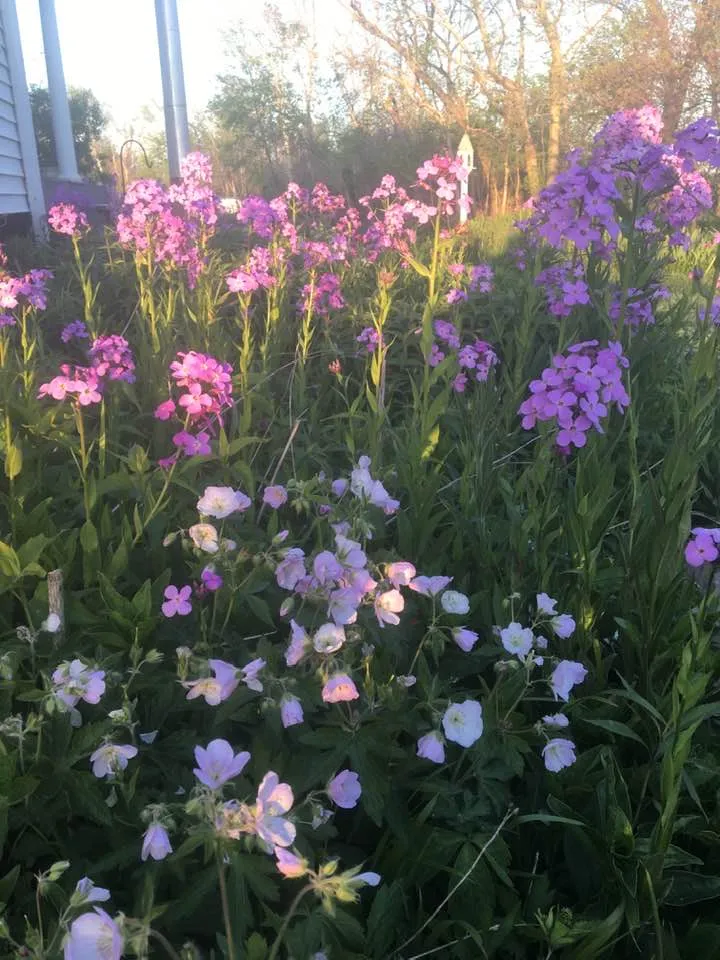
Note: the flowers in the foreground are my woodland native, wild geranium, which appeared here as a volunteer. The taller, brighter, bolder blossom is the intrusive Dame's Rocket.
Dame's rocket (Hesperis matronalis) is a Eurasian biennial belonging to the mustard family. It was introduced to North America in the 1600's and has naturalized itself in moist, wooded areas, but can also invade open areas. It may be sold in garden centers as a perennial and is often included in "wildflower" seed mixes.
Hesperis matronalis is an herbaceous plant species in the family Brassicaceae. It has numerous common names, including dame's rocket, damask-violet, dame's-violet, dames-wort, dame's gilliflower, night-scented gilliflower, queen's gilliflower, rogue's gilliflower, summer lilac, sweet rocket, mother-of-the-evening, and winter gilliflower.
I wish the Dame's Rocket were my only faux pas,
but there are so many more, more than I can fit into a book, much less into one post.
Consider the lily,
Jesus said. I did. I held Lily of the Valley in the highest regard. So beautiful and smells so heavenly, who wouldn't welcome her dainty white bells on slender stalks?
I'm so frustrated at their rate of expansion and tenacity, I don't even want to post a picture of the rhizomes and root system. I've dug, dug, dug, with a spade, for hours, day after day, digging up lily of the valley, and another lily, "Tiger lily," which has its health benefits, yes, and you can have them all. Twenty wheelbarrows full every year since 2017, the magic ten-year mark in which all those lovely flowers I rescued from my mother's chopping and digging gained their foothold on my own poorly guarded turf.
Competition!
So many plants compete to occupy the same square inch of space. It's like one little square foot of my flowerbed is Manhattan and 20 nationalities of immigrants are fighting for their share of the turf. You cannot all fit here. Sorry.
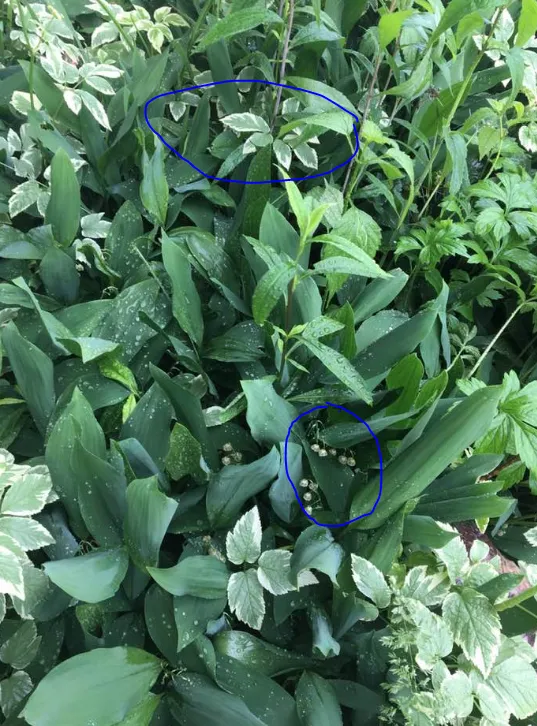
Vinca Minor (periwinkle) is sold to this day at garden nurseries. I want to walk through with a blow torch and blast these plants to garden-hell. Want periwinkle? Come on to my house. I have pulled mountains of it this year. Oh, such pretty blossoms. Oh, so many uses for the herbalist. Come and get it!! I'm still pulling, pulling, and pulling this stuff. "Shade loving." I planted some in the north timber, thinking to slow the more unpleasant natives: poison ivy, buckthorn, half a dozen varieties of sticking, clinging, scratching, deadly vines, like greenbriar (it kills deer! Not gonna subject you to a photo, but a doe who gets trapped in this vine may starve to death.) Hog peanut, bedstraw, I cannot even name all the icky vines offhand, and don't even get me started on motherwort. Wouldn't you expect better with a name like that? Ha. It's so painful to walk past and soooo difficult to remove from clothing. I didn't even mention the worst of the stick-tights, and I'm not going to today. Nope. Not today.
Note: Yes, the vinca took over, and no, it did not choke out the poison ivy or the sticky-icky-awful vines.
NO such luck.
Backing up to the MUSTARD family....Dame's Rocket and its most evil cousin....
Every day is a day for lamenting the one thing I can say I did not plant
I am INNOCENT ....
..... These seeds travel on the fur of large animals, such as horses and deer, and also in flowing water and by human activity. It is because of this, garlic mustard spreads in woodlands and quickly takes over native woodland wildflowers.
Some will defend garlic mustard
as something less than 100% evil, but I give it no quarter. Pull. Pull. Burn. Burn. I used to pull it on properties I didn't own, like the Department of Natural Resources land, and I could not possibly sustain it. You see what happens. Even in a flood plain that's been turned into a monoculture of non-native grass, here come the tens of thousands of garlic mustard seedlings:
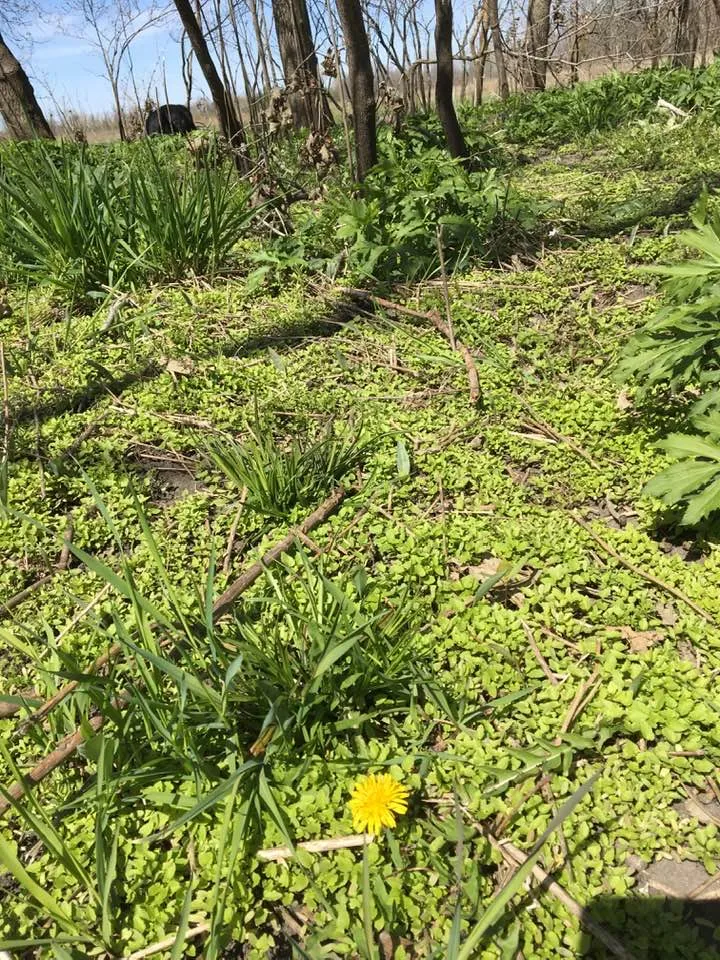
Just how evil is garlic mustard? Pull it up before it's even in flower, in March. Toss into the firepit. Come back in late April, and lo and behold, look what this lone plant hath wrought:

I try to keep up with it, burn it fast, but most of the time, I end up with seven heaping wheelbarrows full. Mountains, literally, MOUNTAINS of garlic mustard to burn, burn, burn. This is the deceptively serene view of the conflagration of early April:
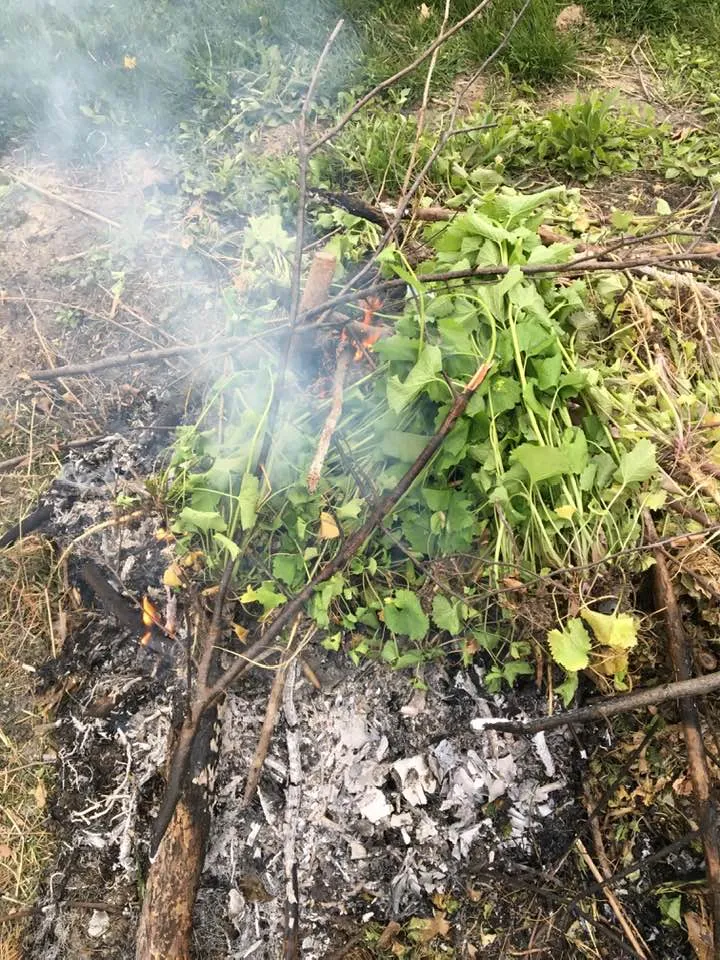
I use the term loosely, and I do watch over my fires, but I have been known, more than once over the years, to cause a 20-foot pine tree to go up in flame, and... well, "Agony in the Garden" has many chapters. Today, it's about my mom and her #NoMercy policy toward pretty, sweet-smelling, but evil garden invaders.
A conflagration isn't just a few flames; it's an especially large and destructive fire that causes devastation. That tiny campfire that somehow turned into a raging forest inferno? You could call that intense, uncontrolled blaze a conflagration.
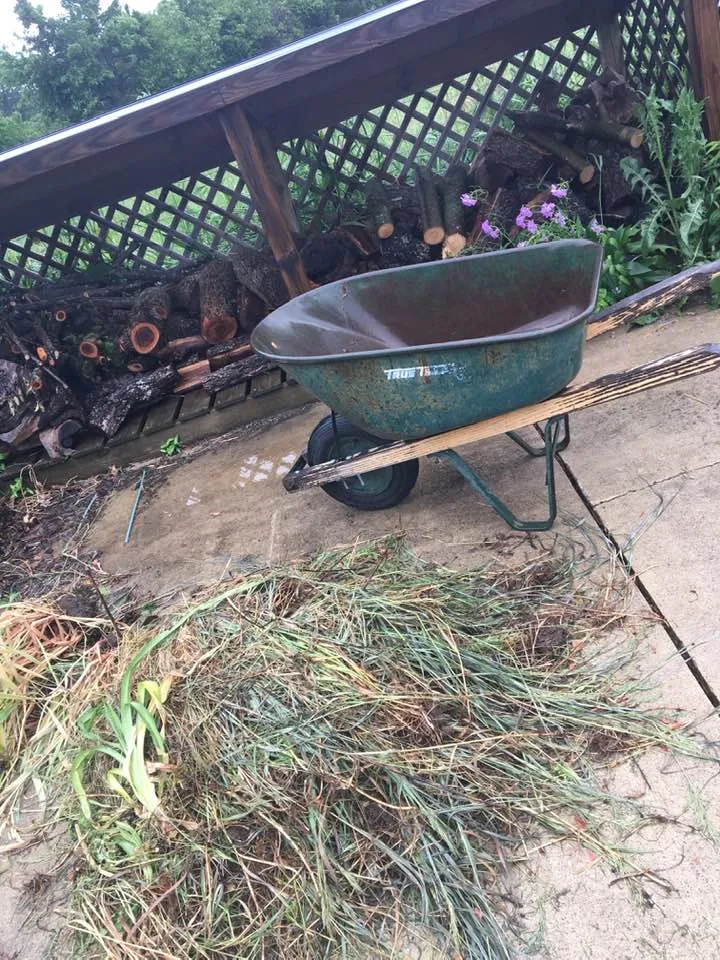
Fiddlehead ferns are native,
going back to the age of the dinosaurs. I have no regrets, planting them by the front door, but they will require due diligence to keep them from Conquering the Universe. In the foreground, the lamium you see is what remains after a through pulling and thinning, believe it or not. Look how it army-crawls up the step to my door.
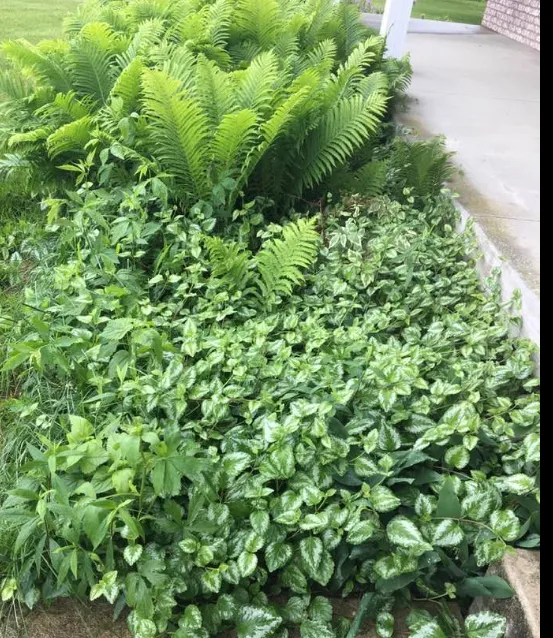
My driveway is longer than a football field with prairie flowers lining it on both sides, and never believe that native prairies get established after a few years and self-maintain. Not when the soil was pasture for so many decades, with seeds that lie dormant for years, springing to life every time some idiot disturbs the dirt. I have created so much work for myself. I have sentenced myself to a chain-gang of weeding out tall non-native grasses and even pretty flowers that just want to choke out all other life forms, cancel diversity, and become a monoculture.
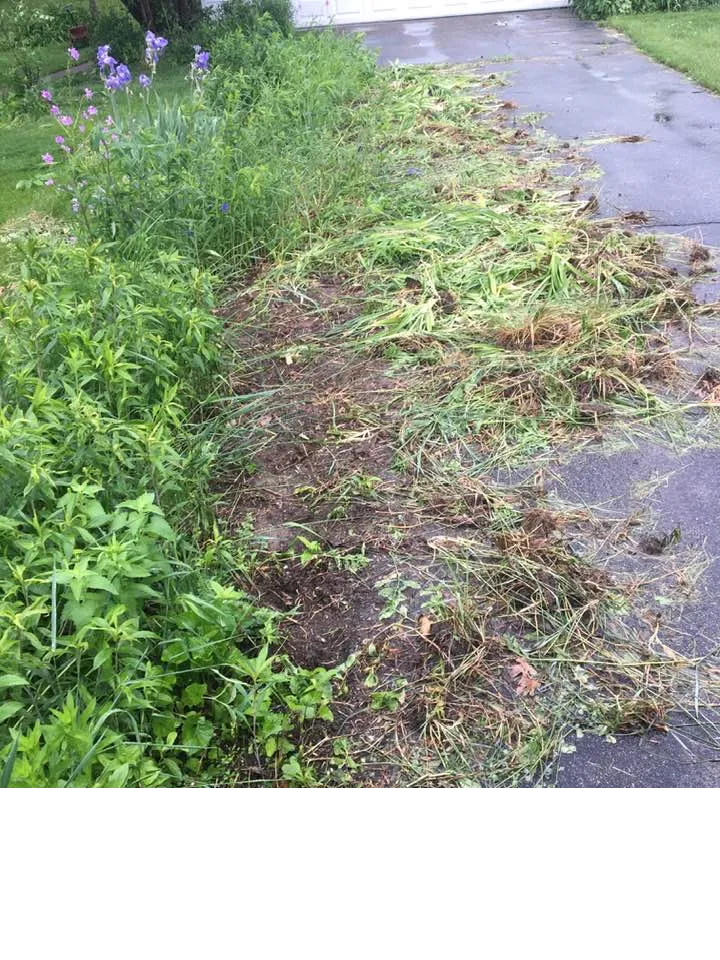
I could name all these plants and tell which lie on the battlefield, dying, or pretending to die but secretly plotting a comeback when I turn my back. I'm too weary to name them for you. If I take time to do that, I might as well write a little chapter book. "Agony in the Garden," by the decade, and if you're Catholic, you'll get the intentions therein. Yes, rather than spend mindless hours weeding with songs like "Bill Bailey's Goat" playing in my head, or repeats of last night's movie replaying in my mind, I try to meditate, focus, dwell on the positive, beam my intentions or prayers to the universe or to whatever God may be listening. I married into Catholicism, after abandoning my Fundamentalist uprbringing. I've internalized a lot of lovely prayers and meditations, met a community of marvelous saints, and invited them to keep me company during my torments in the garden (which of course are absolutely nothing compared to the Agony of Jesus sweating blood and tears in the Garden the night of nights). I'm still a heretic, an unbeliever, a skeptic, but at the same time, I've kept all doors and windows open for any friendly spirits to wander in and say hello as I grub around in the dirt, seeking to restore balance and order, beauty and harmony, and food for the pollinators who in turn feed us, all in the name of the "healing" and "mindful" and restorative work of tending a garden.

The snake grass, aka horsetail, hath tempted me,
and I fear it may become my biggest gardening mistake yet. A pity: I do love this native. This title is a cautionary tale in and of itself:
How to Grow (or Get Rid of) Horsetail Plant
... Horsetail Equisetum arvense or Equisetum hyemale can function as:
A modern-looking landscape accent plant.
A disastrous plant that is extremely difficult to get rid of.
Horsetail is a true survivor. Drastic measures are needed to eradicate it if it takes over your garden or field. With that in mind, we will cover the scouring rush from both perspectives.

I love this primitive grass that goes back farther than the dinosaurs. I dug it up from -- wait for it -- my mom's ditch!!! Somehow, in my half-century of life, I've never seen it overtake her garden, so I dared to move a few over to my little acreage. Give it five or ten years, usually it's ten (decades are magical), and some innocent looking species will morph into the Plague. For now, it's only just beginning to spread, but you should see the warnings other gardeners have posted. I am duly warned. #NoMercy, right?
HORSETAILS AND SNAKE GRASS: RELICS BEFORE THE DINOSAURS
Snake grass, or horsetails as they are known by many, get their roughness and strength from silica in their stems....
The Dutch find value in horsetails, mostly in maintaining the dikes that keep their land dry. The plant has deeply rooted rhizomes (horizontal underground stems) which bind the soil, a helpful aid in reinforcing walls that keep the sea out. A weed anywhere else, it is an asset in Holland.
... Horsetails—snake grass–are not esteemed by those who wish to keep their beaches well-groomed. Their roots are hard to tear out—remember the Dutch and their dikes?—causing them to reappear after great effort has been exerted to remove them. Still, we should appreciate their good qualities: they scour, they sandpaper, they can be tied. Not only that, they provide a glimpse into a different world 350 million years ago. If you see a millipede hanging out among the stems of horsetails, you might be looking out on a scene enacted 380 million years ago. Horsetails deserve our respect for their venerable age. --Richard Fidler
Dear God,
Please do not punish me oh Lord for loving this tenacious you plant you created; let my snake grass thrive without choking out everything else in its path. I am sorry for having waged war on the stinging nettle and the broadleaf plantain. Forgive me my trespasses. Grant me wisdom and discernment. Help me make peace with all the flora, not just the fauna. P.S. "Fauna" does not include stinging, itch-inducing insects. Amen.
Casualties!
My war, my Agony in the Garden, wages all summer long.
It's enough to make me look forward to a long, cold winter, and some of those stinging nettles and horsetail grass natives brewing in a nice, hot tea.
P.S. Please have mercy on the snakes, people. They're a gardener's friend.
Spiders, too.
Chiggers, ticks, mosquitoes, gnats: hell can take them!
And now I will stop raving and revisit these tags: #herbalism #gardening #healing #mentalhealthawareness #minfulness and #naturalmedicine, reminding me, on the heels of my latest gardening disasters, that all is well, and all shall be well. It's a work in progress, and I am a slow learner.
Another day, I will be posting glorious photos of the prairie flowers that made it, and I will rejoice in the sunshine and harmony of nature and all that.
I might even have some peas, thyme, rosemary, and tomatoes lurking after the Dame's Rocket is done blooming and I make room for some herbal medicine outside my back door.
If someone else writes a book of herbal lessons and titles it Agony in the Garden, please report to me ASAP. I didn't even mention the Lumious Mysteries today, though I did hint at the crowning with thorns. And you all know springtime spells R-E-S-U-R-R-E-C-T-I-O-N. One of my favorite decades.
Joyful
Sorrowful
Luminous
Glorious
I'd have used them as hashtags, but only Catholics would get it. You see how many chapters and themes, plants and life events, prayers and hopes, might be woven in with the decades (figuratively and literally):

source: The Rosary Ministry of St. Michael the Archangel
And yes, skeptic that I am, I reflect on these mysteries every day, in the garden, or on nature walks. Why? Well, I'll write the book, and try to explain. Someday!
If I have offended the community with my vehement garden lament, please know that summer isn't the whole story. Great things have happened in the understory (after I chopped out the buckthorn and pulled the ivy).....
Hey, the exodus from Eden hasn't been easy.
